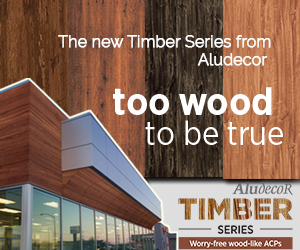From the most common IT Parks and Hospitals to the exteriors of swanky restaurants- Aluminium Composite Panels clad the exterior facades of several architectures, adding up to its glory. Modern in its appearance, sleek and subtle in its finish, ACP clad exteriors look futuristic and aesthetic. While being used exhaustively as a cladding material for buildings, Aluminium Composite Panels also are the first choice of architects to add an added quotient of glitz and glam to interiors of buildings.


To define the structure of Aluminium Composite Panels, it usually consists of a non-aluminium core that adheres two fairly thin coil-coated aluminium sheets. ACPs are mostly used to beautify the most important architectural aspect, the façade of a building but its versatility also allows it to be used for insulation. ACPs can be used for signage, thanks to a vast range of eye-catching colours and textures that it can be fortified with. Similarly, the ACPs that are used for redefining interiors or exteriors of certain buildings could very well mimic different natural textures, colours and finishes. Omnipresent within the urban cityscape, here are the top ten facts that define the efficiency of ACPs.


Aluminium Claddings in the Pre-ACP Days
Having been extracted for the first time in the year of 1854, Aluminium began to be used for commercial purposes in the year 1886. Way before architects were cladding building facades with ACPs, it was the year 1898 when the Romans used Aluminium sheets to cover the dome of San Gioacchino’s church. Using Art Deco as an inspiration, New York’s Empire State Building became the first of its kind to use Aluminium components to add to its aesthetics.


Invention and Patent
In 1969, BASF and ALUSINGEN jointly invented Aluminium Composite Panels or ACPs. Also known popularly as Sandwich Panels, the wide commercialization of ACPs soar high when the twenty years patent (1971-1991) was uplifted by ALUSINGEN on the patented Alucobond. Today, there are nearly two hundred brands worldwide that are manufacturing ACPs.
Extraction
Aluminium is extracted from Bauxite ores in the form of Alumina. Primary Aluminium is further extracted from Alumina, the oxide of Aluminium through the process known as “Electrolysis of Alumina”. Bauxite ores are most commonly found in subtropical and tropical locations such as West Indies, West Bengal, Brazil and Australia.
Safe for the Environment
Taking active parts in solar heating, photovoltaics and energy-saving systems, ACPs have already proven to be energy-efficient, sustainable and environmentally friendly. ACPs are easily recyclable as the Aluminium that has been extracted from the sandwich panels can be easily recycled without any loss of value or quality.
Robust and Rugged Physical Properties
The robust quality of Aluminium Composite Panels makes it perfect as a cladding material for exteriors of any building. Aluminium Composite Panels are corrosion resistant, meaning that they can withstand the effects of weathering. Besides, ACPs can be exposed to a temperature range of -50° to +80° Centigrade, which renders it all the more versatile. ACPs are also known for its insulation properties that significantly counteract the heat and noise-related extremities by keeping the building cooler and quieter. The UV resistant quality of Aluminium Composite Panels also lends to its longevity.


Efficient Ergonomics
ACPs are extremely light in weight and are appreciated all over the architectural world owing to its high rigidity. ACP sheets are also fairly flexible, which allows them to be customised, cut and fit into any desired shape and size. The flat sheets also are highly formable.
Non-Toxicity
It has been observed that extraction workers who are involved in Marble industry are often suffering from Rheumatoid pneumoconiosis, which is a direct result of prolonged exposure to silica dust. However, in the Aluminium industry, such occupational lung diseases are not reported. Besides, ACP sheets are manufactured by following stringent industry standards and quality control measures, making the ACP industry able to omit such exploitation of human health. Furthermore, ACP sheets are hued with high-quality lead and VOC free paint that ensures zero harmful fumes.
Easy Customization
ACP sheets make it possible for architects to express themselves better, thanks to the easy customization properties. ACP sheets can be painted in an array of colours, featuring a plethora of finish and texture even to imitate natural inspirations such as wood bark or natural stone. Besides, by just replacing the core material from Low-Density Polyethylene (LDPE) to Magnesium Hydroxide (MDH), ACPs can be made fire retardant. Furthermore, by embedding silver ions in the ACPs, it is also possible to hinder the growth of bacteria and other harmful microbes.
Effective Heat Insulation with ACP
Aluminium Composite Panels make it so much more cost-efficient when it comes to heat-insulating a building. ACPs protect heat insulation materials against weathering and moisture which pose a threat to their heat-insulating properties. A well ventilated ACP façade is capable to encourage heat insulation owing to the air gaps that retain warmth.


Fortifying the Appearance of Architectural Wonders
ACPs are an ideal choice to add a dose of panache to any building or architectural wonder. The highly coveted lightweight feature along with numerous textures, design and colours that ACP has to offer would let architects bring their vision to life. The most famous instances of such use cases would be the VanDusen Botanical Garden, the geodesic sphere of Spaceship Earth and the Leipzig branch of the German National Library.





